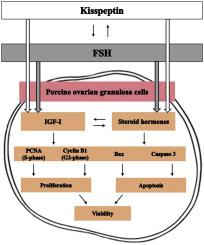Domestic Animal Endocrinology ( IF 2.1 ) Pub Date : 2020-07-06 , DOI: 10.1016/j.domaniend.2020.106520 Z Fabová 1 , A V Sirotkin 1

|
The existing knowledge of the direct action of kisspeptin on the ovary needs to be expanded. In our study, the direct effects of kisspeptin on basic ovarian cell functions and their response to FSH were examined. We studied the effect of kisspeptin alone (0, 1, 10, and 100 ng/mL) and of kisspeptin (1, 10, and 100 ng/mL) in combination with FSH (10 ng/mL) on cultured porcine granulosa cells. Markers of viability, proliferation (accumulation of proliferating cell nuclear antigen [PCNA] and cyclin B1), and apoptosis (accumulation of bax and caspase 3), as well as the release of steroid hormones and IGF-I were analyzed using the trypan blue exclusion test, quantitative immunocytochemistry, and ELISA. Addition of kisspeptin at lower doses (1 and 10 ng/mL) increased cell viability, the accumulation of PCNA and cyclin B1, decreased the accumulation of bax and caspase 3, and promoted release of progesterone, estradiol, and IGF-I, but not testosterone. A high dose (100 ng/mL) of kisspeptin had the opposite, inhibitory effect. The addition of FSH increased cell viability, proliferation, decreased apoptosis, and promoted progesterone, testosterone, estradiol, and IGF-I release. Kisspeptin at lower doses supported the stimulatory action of FSH on viability, PCNA and cyclin B1 accumulation, and release of progesterone and estradiol, promoted its inhibitory action on bax and caspase 3 accumulation, but did not modify its action on testosterone and IGF-I release. On the contrary, kisspeptin at a high dose inhibited and even reversed the FSH effect. FSH mimicked and promoted both the stimulatory and inhibitory action of kisspeptin on all examined ovarian functions besides IGF-I release. These observations show that kisspeptin can directly regulate basal ovarian cell functions. Furthermore, they demonstrate the functional interrelationships between kisspeptin and FSH in direct regulation of ovarian functions.
中文翻译:

Kisspeptin 和 FSH 在控制猪卵巢细胞功能中的相互关系。
关于kisspeptin对卵巢的直接作用的现有知识需要扩展。在我们的研究中,检查了kisspeptin 对基本卵巢细胞功能的直接影响及其对FSH 的反应。我们研究了 Kisspeptin 单独(0、1、10 和 100 ng/mL)以及 Kisspeptin(1、10 和 100 ng/mL)与 FSH(10 ng/mL)组合对培养的猪颗粒细胞的影响。使用台盼蓝排除法分析活力、增殖(增殖细胞核抗原 [PCNA] 和细胞周期蛋白 B1 的积累)和细胞凋亡(bax 和 caspase 3 的积累)以及类固醇激素和 IGF-I 的释放的标志物检测、定量免疫细胞化学和 ELISA。添加较低剂量的kisspeptin(1和10 ng / mL)增加细胞活力,PCNA和细胞周期蛋白B1的积累,减少了 bax 和 caspase 3 的积累,并促进了孕酮、雌二醇和 IGF-I 的释放,但不促进睾酮的释放。高剂量 (100 ng/mL) 的 Kisspeptin 具有相反的抑制作用。FSH 的加入增加了细胞活力、增殖、减少细胞凋亡,并促进了孕酮、睾酮、雌二醇和 IGF-I 的释放。较低剂量的 Kisspeptin 支持 FSH 对活力、PCNA 和细胞周期蛋白 B1 积累以及孕酮和雌二醇释放的刺激作用,促进其对 bax 和 caspase 3 积累的抑制作用,但没有改变其对睾酮和 IGF-I 释放的作用. 相反,高剂量的kisspeptin抑制甚至逆转FSH效应。除了 IGF-I 释放外,FSH 模拟并促进了 Kisspeptin 对所有检查的卵巢功能的刺激和抑制作用。这些观察结果表明,kisspeptin 可以直接调节基底卵巢细胞功能。此外,他们证明了kisspeptin和FSH在直接调节卵巢功能方面的功能相互关系。



























 京公网安备 11010802027423号
京公网安备 11010802027423号